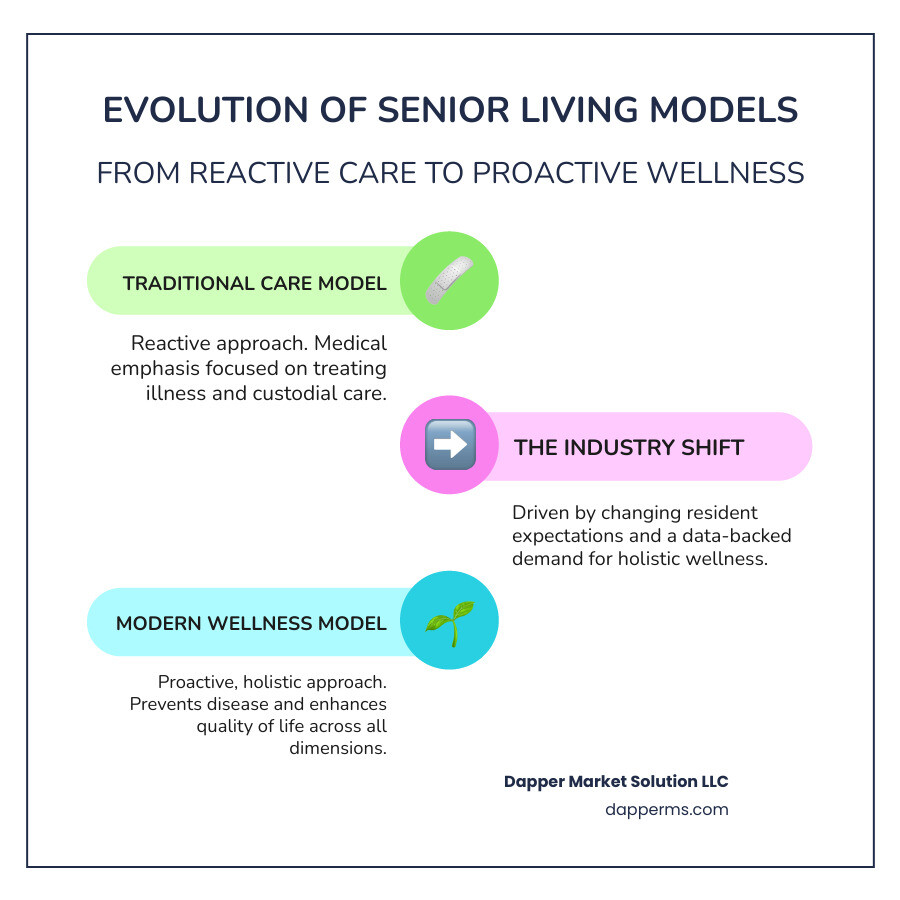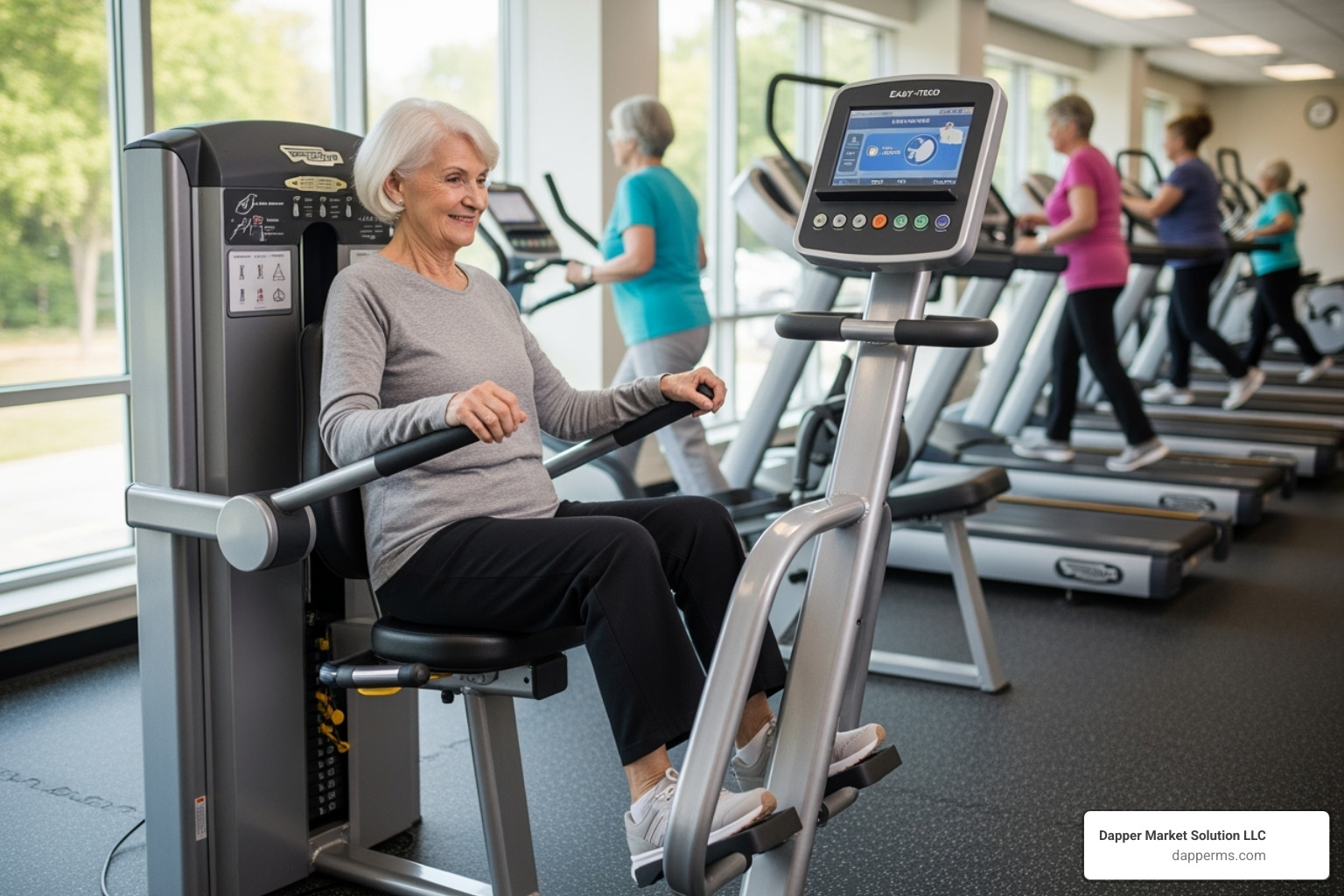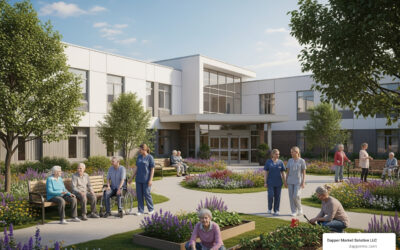

Beyond the Basics: Exploring Innovative Senior Living Wellness Trends
The New Era of Senior Wellness
Senior living wellness has evolved beyond medical care and safety into a proactive approach that nurtures physical health, mental vitality, social connection, and emotional well-being. Modern seniors and their families now prioritize communities that offer:
- Holistic health programs addressing physical, social, intellectual, emotional, and spiritual dimensions
- Engaging activities from functional fitness and brain vitality studios to art classes and volunteer opportunities
- Technology integration including telehealth, wearable health trackers, and social connection apps
- Resident empowerment through leadership roles, feedback channels, and personalized wellness plans
- Proven outcomes with 91% of residents in wellness-focused Life Plan Communities reporting good to excellent health
The senior living industry is undergoing a significant change. Where communities once focused on custodial care, today’s leading operators accept a wellness-based model emphasizing prevention and personalized experiences. This shift is driven by data: nearly 50% of prospective residents now choose their community based on wellness offerings, making robust wellness programs a crucial market differentiator.
This evolution reflects that older adults are living longer, healthier lives and want environments where they can thrive—pursuing passions, learning new skills, and building meaningful friendships. As Deepak Dashairya, I’ve seen how effectively communicating a community’s wellness value proposition can drive success. At Dapper Market Solutions, we’ve helped communities showcase their senior living wellness programs to increase occupancy from 40% to 100% with waitlists.

The Core Dimensions of Modern Senior Living Wellness
Modern senior living wellness is a holistic philosophy that nurtures every part of a person. Forward-thinking communities have moved beyond a simple checklist, embracing a comprehensive approach that includes physical health, social connections, intellectual growth, emotional resilience, and spiritual fulfillment. This integrated view recognizes that true wellness means functioning optimally, building resilience, and finding ways to thrive.
Physical Wellness: More Than Just Movement
Physical wellness in senior living is more than just activity; it encompasses nutrition, preventative care, and an environment where the body can flourish.

Modern communities offer varied ways to stay strong, including functional fitness classes that help with everyday activities, joint-friendly aquatic classes, yoga, and tai chi. Balance exercises are especially important, as they improve stability and coordination to prevent falls. Falls are a major health risk, and a national prevention plan highlights the crucial role of senior living communities in reducing them.
Regular exercise builds muscle, improves heart and lung function, and boosts circulation. But physical wellness also includes nutritious dining. Leading communities feature chef-prepared meals with fresh ingredients and have dietitians on staff. This is critical, as a 2018 study found one-third of seniors don’t get enough protein, which is essential for muscle health. Preventative health screenings, vaccinations, and easy access to medical appointments round out the physical wellness picture, keeping residents thriving.
Social Wellness: The Power of Connection
Human connection is vital to health, yet approximately one-quarter of adults aged 65 and older are considered socially isolated. This poses a major risk for premature mortality, comparable to smoking or obesity, and increases the risk of heart disease, depression, and cognitive decline.
A report on social isolation in older adults highlights this serious issue. Senior living communities are uniquely positioned to combat this by creating environments rich with connection.
Community building happens through resident clubs (gardening, book discussions, games), shared meals in multiple dining venues, and social events. Intergenerational programs, such as college students hosting a senior prom, bridge generational gaps. Newcomer groups, volunteer opportunities, and family events also help forge and maintain strong bonds.
Staying socially active improves cognitive function, mood, and even cardiovascular health. Strong social bonds directly correlate with better overall health, and some research suggests that combating loneliness can help mitigate the onset of dementia.
Intellectual and Vocational Wellness: A Purpose-Driven Life
Lifelong learning is essential for maintaining cognitive health and a sense of purpose. Research on lifelong learning benefits shows that a curious mind is associated with a reduced risk of Alzheimer’s disease. Communities that prioritize intellectual wellness offer rich opportunities to keep the brain engaged.

Offerings include libraries, book clubs, technology workshops, brain fitness events, guest lectures, and art classes. Vocational wellness takes this further by providing purposeful engagement. This can mean mentorship roles, serving on resident-led committees, or volunteer opportunities.
Utilizing life skills from a lifetime of experience provides a deep sense of accomplishment. Whether it’s studio art, woodworking, or gardening, maintaining hobbies helps preserve cognitive function and reduces stress. When residents have opportunities to lead, teach, and contribute, they don’t just stay busy—they thrive.
Emotional and Spiritual Wellness: Nurturing the Inner Self
True senior living wellness addresses the inner world—emotions, meaning, and spiritual well-being. Emotional well-being improves memory and decision-making, while chronic stress can impair cognitive abilities. Leading communities provide support groups, social workers, and grief counseling.
Mindfulness practices like meditation and deep breathing help manage stress. Structured programs like “Make it OK” and the “Community Resiliency Model” equip residents and staff with tools for mental well-being.
Spiritual wellness is nurtured in inclusive environments. This might include interfaith worship services, resident-led Bible study, chaplain services, and quiet reflection spaces. Those who use spirituality to cope often experience better mental health.
Spiritual wellness also includes connecting with nature through gardening clubs or nature walks, finding comfort in pet therapy, or simply having peaceful spaces for contemplation. According to the National Wellness Institute, wellness means addressing the whole person to build resilience and thrive through life’s challenges.
How Communities Champion a Culture of Wellness
A true culture of wellness requires an integrated approach, where health and vitality are woven into the fabric of community life. Every program and decision should reflect a commitment to helping residents thrive.
Popular and Innovative Wellness Programs
The landscape of senior living wellness is constantly evolving beyond traditional exercise classes. Forward-thinking communities are expanding their offerings to engage residents’ bodies, minds, and spirits.
Health education seminars and disease management workshops empower residents with knowledge to manage their own health, from diabetes to medication management.
Brain vitality studios use specialized equipment and dual-tasking exercises to improve neuroplasticity, helping residents keep their minds sharp, like the studio at Vi at La Jolla Village.
Creative arts therapy programs like “Opening Minds Through Art” (OMA) provide outlets for self-expression and stress reduction, even for those with cognitive changes. Offerings range from studio art and woodworking to chorus groups.
Culinary exploration classes, or “Wellness Kitchens,” allow residents to learn to cook healthy meals, explore new cuisines, and bond with neighbors.
Personalized fitness plans and functional fitness programming, guided by trainers, ensure each resident can work toward individual goals like improving balance or building strength.
Intergenerational programs create meaningful connections between residents and younger generations, while technology integration, from computer courses to tablets, helps residents stay mentally active and connected.
This diverse menu reflects a shift to a “wellness mindset” that promotes independence and joy. For communities looking to showcase these offerings, our article on Proven Senior Living Marketing Strategies That Drive Results offers valuable insights.
Technology’s Role in Enhancing Senior Living Wellness
Technology is now an integral component of modern senior living wellness, offering solutions to keep residents safe, connected, and engaged.
Wearable health trackers allow residents to monitor vital signs, activity levels, and sleep patterns, empowering them to take an active role in their health.
Smart home features like automated lighting systems and timed medication dispensers improve safety and provide peace of mind.
Telehealth services have revolutionized healthcare access, allowing for convenient virtual doctor appointments and consultations with specialists.
To combat social isolation, social connection apps designed for seniors simplify staying in touch with family and friends. The internet is also a valuable resource for learning and engagement.
Brain-training games and virtual reality experiences offer engaging ways to stimulate cognitive function. VR can even transport residents to far-off places.
Digital activity calendars through platforms like Welbi keep residents and families informed about events, making it easier to participate.
By embracing these advancements, communities improve quality of life while providing families with the peace of mind that their loved ones are safe and supported.
Fostering Engagement for Residents and Staff
A vibrant culture of senior living wellness is cultivated through the active engagement of both residents and staff.
Resident empowerment is foundational. When residents have a voice through resident councils and other feedback channels, they can initiate clubs, lead activities, and shape programming. This sense of ownership increases participation and makes offerings more relevant.
We’ve seen how communities transform when they act on resident input, as highlighted in our blog post about how one community transformed its strategy.
Staff engagement is equally crucial. A culture of wellness starts with comprehensive staff training on wellness principles. When staff understand and embody this holistic approach, they become natural champions for residents.
Inclusive language that focuses on abilities rather than limitations shifts the community’s tone. When combined with leadership by example—where staff participate in wellness initiatives—it creates a shared sense of purpose.
Collaborative program design, where staff and residents plan activities together, ensures offerings meet diverse needs. Ongoing resident feedback channels make this collaboration a continuous process, creating a community that truly feels like home.
The Tangible Benefits of a Wellness-Focused Community
When senior living communities adopt a wellness-centric model, they deliver real, measurable improvements in residents’ health, happiness, and satisfaction. These benefits are evident in health metrics and the vibrant energy of the community.
Improved Health Outcomes and Longevity
The strongest evidence for senior living wellness programs is in the results. These programs help residents thrive, adding vibrancy and vitality to their years.
The numbers are compelling. In Life Plan Communities with comprehensive wellness programs, 91% of residents report their health as good, very good, or excellent. These residents consistently demonstrate greater wellness across all dimensions compared to older adults living elsewhere.
These outcomes are driven by the combination of regular physical activity, intellectual stimulation, strong social connections, and emotional support. Research from studies on quality of life in senior housing confirms that residents experience the same or better outcomes compared to peers living independently. Many feel healthier and more energetic than they have in years, leading to longer, happier stays within the community.
Key Benefits of Prioritizing Senior Living Wellness
The impact of prioritizing senior living wellness creates a ripple effect, improving every aspect of daily life.
The primary benefit is an improved quality of life. When communities address all dimensions of wellness, each day holds purpose and possibility. Residents have activities to look forward to, friends to connect with, and opportunities to grow.
This approach supports greater independence. Functional fitness programs help residents maintain mobility for daily tasks, while disease management workshops empower them to make informed health choices, allowing them to maintain autonomy longer.
Increased resident satisfaction is a natural result. When people feel supported and engaged, their overall happiness soars. This is reflected in community surveys, retention rates, and enthusiastic referrals.
A stronger sense of community develops as shared activities foster deep connections, creating a supportive network where neighbors become family.
Perhaps most importantly, these communities combat reduced social isolation. By building robust activity calendars and encouraging interaction, they provide genuine assistance in dealing with issues like depression and reduced mobility. In a vibrant wellness community, loneliness is actively addressed.
For operators, these benefits are powerful differentiators. Our guide on Assisted Living SEO Strategies for Winning Local Markets: A Guide can help showcase these strengths.
Creating a Compelling Wellness Narrative
In today’s market, having great wellness programs isn’t enough. You must craft a compelling wellness narrative that tells your community’s unique story.
Focus on positive growth, not decline. Frame your community as a place where new chapters begin—a place to master a new skill, mentor others, or refind a love of learning.
Showcase resident success stories. Testimonials and video interviews bring your philosophy to life in a way that program descriptions cannot. An authentic story from a resident is your most powerful marketing tool.
Personalize marketing messages. Different prospects prioritize different aspects of wellness, from intellectual stimulation to fitness or social life. Tailor your messaging to speak directly to their interests.
Highlight unique programs that set you apart. Whether it’s a Brain Vitality Studio, a culinary wellness program, or intergenerational partnerships, these distinctive elements should be prominent in your narrative.
Emphasize proactive health over reactive care. Position your community as a partner in prevention and long-term vitality, where healthy habits are naturally supported.
Weaving this story into your marketing requires strategic execution. Our Senior Living Web Design & Development services can help ensure your digital presence effectively communicates your wellness narrative.
Frequently Asked Questions about Senior Living Wellness
What is the main difference between a “care” model and a “wellness” model?
The care model is reactive, focusing on treating health issues as they arise. It centers on medical interventions and assistance after a need becomes apparent.
The wellness model is proactive and preventive. It aims to prevent illness and improve overall quality of life across multiple dimensions: physical, social, intellectual, emotional, and spiritual. Rather than just managing conditions, senior living wellness fosters an environment where residents make active choices for a more vibrant life. It empowers seniors to thrive, not just survive.
How can I evaluate a community’s wellness program?
To evaluate a wellness program, look deeper than the fitness center. A truly comprehensive program is integrated into the community’s culture.
- Request activity calendars for several months to assess the variety and frequency of offerings across all wellness dimensions.
- Ask about resident involvement in program planning. The best cultures feature resident-led initiatives, showing the community values resident input.
- Observe staff-resident interactions. Do staff seem genuinely engaged and supportive? Do residents appear happy and comfortable?
- Inquire about all dimensions of wellness, including their approach to combating social isolation, their nutrition philosophy, and programs for intellectual and spiritual exploration.
What role does nutrition play in a holistic wellness program?
Nutrition is a cornerstone of holistic senior living wellness, directly impacting physical energy, cognitive function, and disease prevention.
Leading communities offer chef-prepared, nutrient-dense meals, often using fresh, local ingredients. They create thoughtful dining experiences, not institutional cafeteria meals.
It is also crucial to accommodate special dietary needs, whether for low-sodium, gluten-free, or other specific requirements, without sacrificing quality or taste.
Many communities also provide nutrition education classes or “Wellness Kitchens” to empower residents with knowledge for making healthy choices. Quality programs emphasize proper hydration and protein intake, as many seniors don’t get enough protein for maintaining muscle health. Good nutrition is the foundation that supports all other aspects of wellness.
Conclusion: The Future of Senior Living is Holistic Wellness
Senior living has evolved far beyond simply providing care. The industry is embracing a comprehensive wellness model that recognizes older adults as whole people with potential for growth. This shift is redefining what it means to age well, creating vibrant communities where residents don’t just live, but truly thrive.
The future of senior living is holistic, nurturing every dimension of well-being—physical, social, intellectual, emotional, spiritual, and purposeful. When communities adopt this approach to senior living wellness, residents experience better health, families gain peace of mind, and the community builds a stronger brand.
However, having an exceptional program is only half the battle; you must also share your story effectively. Prospective residents are searching for communities that align with their lifestyle goals and want to know what makes your approach unique.
At Dapper Marketing Solutions, we specialize in helping senior living communities transform their online presence and build meaningful connections with families. We know how to craft narratives that highlight your commitment to holistic wellness and showcase your innovative programs.
Whether through strategic SEO, engaging website design, or authentic resident stories, we’re here to amplify your message. The shift to wellness-focused senior living creates incredible opportunities for communities that can effectively communicate their value.
Ready to lift your community’s presence and reach more families seeking an enriching retirement experience? Explore our dedicated Senior Living marketing services. Together, we can help you tell your wellness story in a way that inspires, connects, and grows your community.





